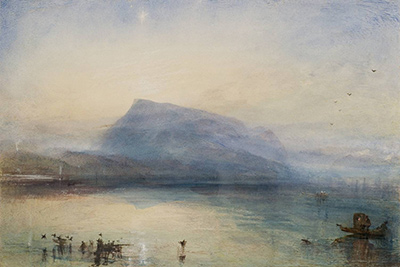Less-well known by its full name, 'The Blue Rigi, Sunrise' came to existence in 1842 and is one of William Turner's later paintings.
A simple watercolour of a mountain rising in gentle mist above a peaceful lake, it carries a dignity with it that is signature for this stage in J. M. W. Turner's life.
The mountain itself, Rigi, is found in central Switzerland in the Lucerne area. The blue colour comes from the shine of the sunrise.
Turner was known both in his own time and ours for his use of light, and in this watercolour it is not difficult to understand how he came by this reputation.
Despite the cool colours, the early morning light warms the mountain scene and brings the figures near the foreground to life.
Though Turner was better known for his use of oils, 'The Blue Rigi' may be one of his best examples of his use of watercolours. With a masterful use of layers of colour, Turner created a vivid scene in the hazy shapes.
Though simple, the mountain itself has depth and strong shape to it, and the water ripples beneath it.
One of the most striking details in the painting is the star above the mountain, a small cut of white that catches the eye. This 'star' is in fact Venus shining through the dawn sky, and was created by scratching the paint with his fingernail.
It is details like this that bring Turner's creations to life, and it is easy to forget that this is only watercolour on canvas rather than a real scene.
Turner was fascinated by Rigi, a mountain sometimes called "The Queen of Mountains". He painted it a number of times. This version is currently on display in the Tate Gallery in London, United Kingdom; it was purchased in 2007 for nearly five million pounds.
There is something in majesty of the mountain that drew Turner into painting it at least three times, not including his preparatory sketches (also owned by the Tate).
In Blue Rigi, Turner succeeds in bringing the beauty of the mountain to the casual observer and creates a vivid, light-drenched scene around it.




